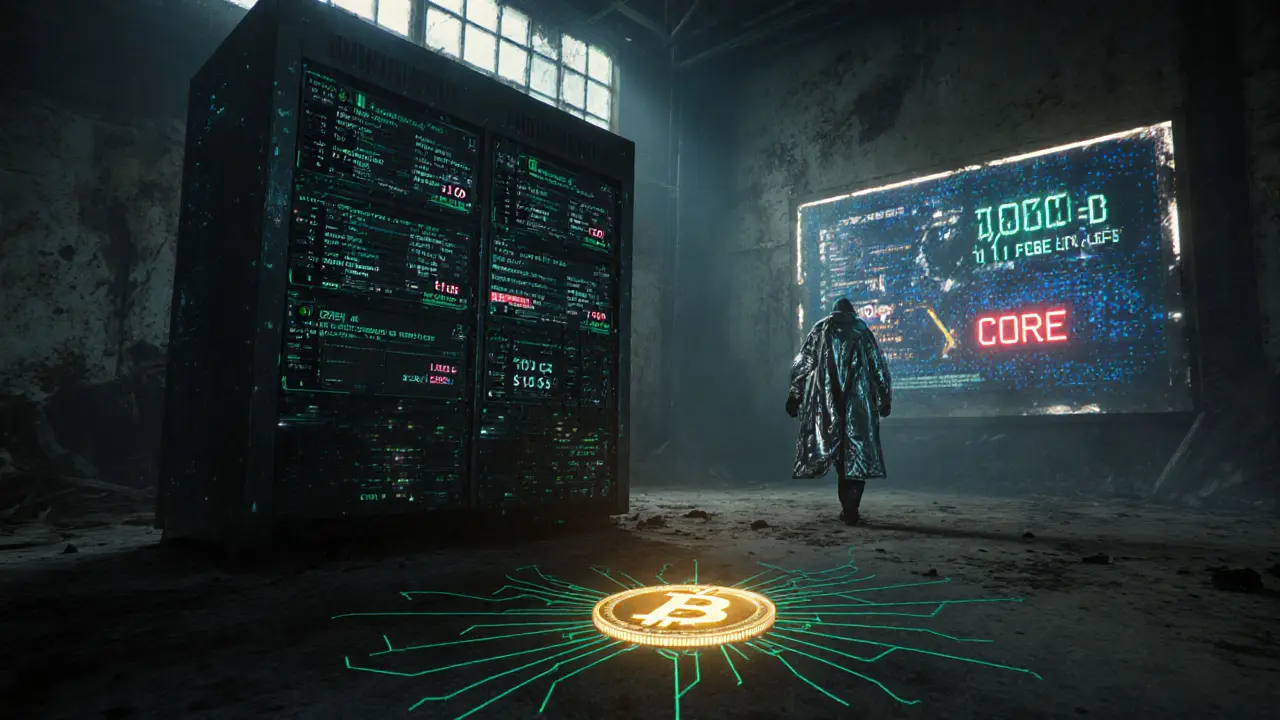Core Staking Yield Calculator
Calculate Your Staking Returns
Estimate potential earnings from staking your Bitcoin on Core blockchain using the current APY rates. Note: Actual returns may vary based on network activity.
Core (CORE) isn’t just another crypto coin. It’s a blockchain built to give Bitcoin new powers - without touching a single Bitcoin. Launched in January 2023, Core is a Layer 1 blockchain that lets Bitcoin holders earn yield, run smart contracts, and access DeFi - all while keeping their BTC safely on the Bitcoin network. This isn’t a sidechain or a wrapped token. It’s a whole new chain that borrows Bitcoin’s security and layers on Ethereum-like functionality. Think of it as Bitcoin’s upgrade path, written in code.
How Core Works: The Satoshi Plus Consensus
Core’s secret sauce is called Satoshi Plus. It’s a hybrid consensus mechanism that pulls together three groups of participants to secure the network: Bitcoin holders, Bitcoin miners, and CORE token holders. Each group plays a different role, and together they make the chain more secure than any single-layer blockchain.
- Self-Custodial Bitcoin Staking: Bitcoin owners can lock their BTC in a timelock contract. This doesn’t move their coins off Bitcoin. Instead, it lets them vote for validators on Core. The more BTC they lock, the more voting power they get.
- Delegated Proof of Work: Bitcoin miners can delegate their hash power to vote for validators on Core. This means miners who are already securing Bitcoin can also help secure Core - without running extra hardware.
- Delegated Proof of Stake: People who own CORE tokens can lock them up to vote for validators. This adds another layer of economic security, similar to Ethereum’s PoS.
This three-pronged approach is unique. Most blockchains rely on one group - either miners or stakers. Core uses all three. That’s why it claims to inherit Bitcoin’s 14-year track record of security while still being able to process 1,000 transactions per second.
Why EVM Compatibility Matters
Core is fully compatible with the Ethereum Virtual Machine (EVM). That means any smart contract written in Solidity for Ethereum can run on Core with little to no changes. Developers don’t need to learn a new language. Tools like MetaMask, Hardhat, and Remix work out of the box.
This makes Core a natural home for DeFi projects that want to tap into Bitcoin’s liquidity. Instead of building on Solana or Polygon - chains that have their own security models - teams can build on a chain that’s secured by Bitcoin. Projects like Bitcoin-backed lending platforms, yield aggregators, and NFT marketplaces are already live. As of April 2024, over 127 active projects were built on Core, including 45 DeFi protocols and 32 NFT marketplaces.
Transaction fees on Core are low - often under $0.01 - and confirmation times are under 3 seconds. That’s faster than Ethereum mainnet and cheaper than most Layer 2 solutions.
The CORE Token: Supply, Distribution, and Inflation Control
The CORE token has a hard cap of 2.1 billion - the same as Bitcoin’s 21 million BTC. This isn’t a coincidence. Core’s team wanted to mirror Bitcoin’s scarcity principle.
Unlike Bitcoin, which releases new coins every 10 minutes, CORE rewards are distributed over 81 years. The annual block reward decreases by 3.6% each year, creating a slow, predictable deflationary pressure. A portion of transaction fees and rewards is also burned by the Core DAO, further reducing supply.
As of November 2025, the circulating supply is around 1.05 billion CORE. That’s roughly half of the total cap. The remaining coins will be released gradually over the next 56 years. This long-term distribution model is designed to avoid early dumping and encourage long-term participation.

What Core Can Do - And What It Can’t
Core excels in one area: connecting Bitcoin to DeFi. If you own BTC and want to lend it, borrow against it, or earn yield without selling it, Core is one of the few places where you can do that trustlessly. Projects like Bitcoin Lending Protocol and CoreStake let users lock BTC and earn 2-5% APY in CORE tokens.
But Core isn’t built for speed. While it handles 1,000 TPS, Solana does 2,000-4,000 TPS. If you’re building a high-frequency gaming app or a social media platform with millions of daily users, Core isn’t the right fit. It’s designed for financial use cases, not mass consumer apps.
It also doesn’t solve Bitcoin’s scaling problem directly. You still need to move BTC to Core via a bridge. That means you’re trusting a cross-chain mechanism - not the Bitcoin network itself. While the bridge is audited and non-custodial, it’s still a potential point of failure.
Adoption and Community: Growing, But Still Niche
Core’s user base is small but highly technical. Chainalysis data shows 78% of Core wallet holders have been in crypto for over two years. Most are developers, DeFi power users, or Bitcoin maximalists looking for yield.
The community is active. Core has a 12,400-member Discord server and an 8,700-member Telegram group. Daily activity is steady, with developers sharing code, users reporting bugs, and governance proposals being debated. There are 14 active GitHub repositories with 287 contributors.
But adoption is still limited. As of Q1 2024, Core processed about 120,000 daily transactions. Compare that to Polygon, which handles over 7 million. Core’s market cap sits around $210 million - tiny compared to Ethereum’s $300+ billion. It’s a niche project with big ambitions.

Price Predictions and Risks
Price forecasts for CORE vary wildly. Changelly predicts it could hit $13.22 by 2030 and $1,571 by 2050. Those numbers are based on speculative growth models and are not grounded in current adoption trends. Professor David Yermack from UC Berkeley called such projections “unrealistic,” pointing out that only 3 of the top 100 cryptos have ever seen 10x growth over five years.
Real risks are more concrete:
- Bitcoin miner dependence: If Bitcoin mining becomes unprofitable - say, after the next halving in 2028 - miners might stop supporting Core. That could weaken the network’s security.
- Low liquidity: CORE is thinly traded on many DEXs. Slippage can be high, and some exchanges delist it due to low volume.
- Regulatory uncertainty: The SEC is watching. While CoinCenter says CORE is likely a utility token, that could change if governance power becomes too centralized.
- Developer friction: While EVM-compatible, integrating Bitcoin staking is complex. 63% of developers surveyed said it was harder than expected.
What’s Next for Core?
The roadmap is ambitious. Core plans to integrate the Bitcoin Lightning Network by late 2024, which would allow instant, near-zero-cost transfers between Core and Bitcoin. In 2025, they’ll launch a cross-chain messaging protocol to connect with other EVM chains like Arbitrum and Optimism. By the end of 2025, they aim to offer institutional custody solutions - making it easier for hedge funds and asset managers to get involved.
The next major upgrade, Satoshi Plus 2.0, will introduce dynamic fee adjustments and improved validator incentives. This could help stabilize rewards and reduce the 15-20% monthly volatility some users have reported.
Is Core Worth Your Attention?
If you’re a Bitcoin holder looking for yield without giving up custody - yes. If you’re a developer who wants to build DeFi apps on Bitcoin’s security - yes. If you’re looking for a quick 10x pump - probably not.
Core isn’t a flashy trend. It’s a quiet, technical experiment. It’s trying to solve a real problem: How do you make Bitcoin more useful without breaking its core promise? So far, it’s working. But it’s still early. The network’s success depends on Bitcoin miners, developers, and users sticking with it for years - not months.
It’s not for everyone. But for those who believe Bitcoin should do more than just store value, Core might be one of the most important blockchains to watch.
Is CORE the same as Bitcoin?
No. CORE is the native token of the Core blockchain, which is a separate network from Bitcoin. Bitcoin (BTC) is the original cryptocurrency with its own blockchain. Core uses Bitcoin’s security but adds smart contract functionality. You can lock BTC on Core to earn yield, but you can’t send BTC directly on the Core chain.
Can I stake Bitcoin on Core?
Yes, but not in the traditional sense. You can timelock your BTC in a non-custodial contract on Core. This doesn’t transfer your BTC - it just lets you use it to vote for validators and earn CORE rewards. Your Bitcoin stays on the Bitcoin blockchain the whole time.
Is Core better than Ethereum?
It depends on what you need. Ethereum has far more users, developers, and liquidity. Core is smaller and newer. But if you want Ethereum-like smart contracts secured by Bitcoin’s security model, Core is unique. It’s not a replacement - it’s a complementary option for Bitcoin-focused DeFi.
Why does Core have a 2.1 billion token cap?
It’s a deliberate nod to Bitcoin’s 21 million supply cap. The team wanted to signal scarcity and long-term value preservation. The 2.1 billion cap allows for more granular token distribution while still maintaining the same proportional scarcity as Bitcoin.
Is CORE a security?
Currently, regulators haven’t classified it as one. CoinCenter’s analysis says CORE functions as a utility token - used for governance and network participation. But the SEC is monitoring it. If governance power becomes too concentrated, or if rewards are seen as profits from others’ efforts, that could change.
How do I get CORE tokens?
You can buy CORE on major exchanges like Gate.io, KuCoin, and OKX. You can also earn it by staking Bitcoin on the Core network or by providing liquidity on Core-based DeFi protocols. Always use a non-custodial wallet like MetaMask or Core Wallet to store your tokens.
Is Core safe to use?
The Core blockchain itself has not been hacked. Its Satoshi Plus consensus is designed to be secure. But cross-chain bridges and DeFi protocols built on Core carry risks - like any smart contract. Always audit contracts before interacting, and never deposit more than you can afford to lose.




